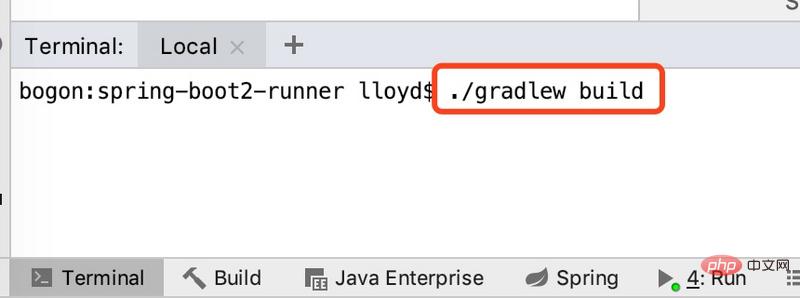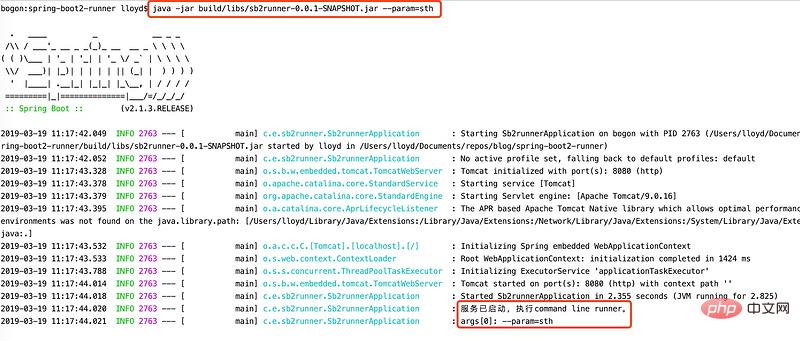Introduction to CommandLineRunner and ApplicationRunner
This article brings you an introduction to CommandLineRunner and ApplicationRunner. It has certain reference value. Friends in need can refer to it. I hope it will be helpful to you.
CommandLineRunner and ApplicationRunner are interfaces provided by Spring Boot. They both have a run() method. All beans that implement them will be automatically called after the Spring Boot service is started.
Due to this feature, they are an ideal place to do some initialization work, or write some test code.
CommandLineRunner
Use Application to implement
After we create a new project, for simplicity, we directly use the Application class to implement the CommandLineRunner interface. Annotations for this class @SpringBootApplication will automatically configure it for us.
package cn.examplecode.sb2runner;
import org.slf4j.Logger;
import org.slf4j.LoggerFactory;
import org.springframework.boot.CommandLineRunner;
import org.springframework.boot.SpringApplication;
import org.springframework.boot.autoconfigure.SpringBootApplication;
@SpringBootApplication
public class Sb2runnerApplication implements CommandLineRunner {
private static Logger logger = LoggerFactory.getLogger(Sb2runnerApplication.class);
public static void main(String[] args) {
SpringApplication.run(Sb2runnerApplication.class, args);
}
@Override
public void run(String... args) throws Exception {
logger.info("服务已启动,执行command line runner。");
for (int i = 0; i <p>Next we start the service directly, check the log as follows, and find that the run() method is executed normally: </p><pre class="brush:php;toolbar:false">Tomcat started on port(s): 8080 (http) with context path ''
Started Sb2runnerApplication in 2.204 seconds (JVM running for 3.161)
服务已启动,执行command line runner。Parameter passing
The run() method has Variable parameter args, this parameter is used to receive command line parameters. Let’s add parameters to test:

Then restart the service and observe the log, You can see that the parameters are received normally:
Tomcat started on port(s): 8080 (http) with context path '' Started Sb2runnerApplication in 1.888 seconds (JVM running for 2.41) 服务已启动,执行command line runner。 args[0]: --param=sth
Command line parameter transfer
We said before that a major advantage of using Spring Boot is that the project can be packaged directly into a jar package without the need to deploy it separately. After packaging into a jar package, you can directly execute the jar package to start the service. In this way, when executing the jar package, we can pass in the command line parameters and let CommandLineRunner receive the parameters.
This scenario is particularly common on servers. For example, if we want to perform an operation without exposing it to the outside world, we can use CommandLineRunner as the entry point for the operation.
Let’s create a jar package to demonstrate.
- Enter the terminal interface and start packaging

- After the packaging is completed, execute the jar package. Remember to first install the IDE Service stopped.

#You can see from the log that we also obtained the parameters normally. By passing parameters, we can perform different operations based on different parameters in business logic.
What we mentioned above is just one CommandLineRunner. What if we have multiple CommandLineRunner? How to control the order in which they are executed?
Now we will introduce how to specify the order of execution.
Specify the order of execution
Spring Boot provides us with an annotation "@Order", which can be used to specify the order of execution. For example, there are three CommandLineRunners in our project:
@Component
@Order(1)
public class CommandRunner1 implements CommandLineRunner {
private static Logger logger = LoggerFactory.getLogger(CommandRunner1.class);
@Override
public void run(String... args) throws Exception {
logger.info("执行第一个command line runner...");
}
}
@Component
@Order(2)
public class CommandRunner2 implements CommandLineRunner {
private static Logger logger = LoggerFactory.getLogger(CommandRunner2.class);
@Override
public void run(String... args) throws Exception {
logger.info("执行第二个command line runner...");
}
}
@Component
@Order(3)
public class CommandRunner3 implements CommandLineRunner {
private static Logger logger = LoggerFactory.getLogger(CommandRunner3.class);
@Override
public void run(String... args) throws Exception {
logger.info("执行第三个command line runner...");
}
}We can directly add the @Order annotation to this class, and then Spring Boot will execute it in the order specified by our annotation from small to large. Pretty simple, isn't it?
Tomcat started on port(s): 8080 (http) with context path '' Started Sb2runnerApplication in 1.764 seconds (JVM running for 2.292) 执行第一个command line runner... 执行第二个command line runner... 执行第三个command line runner...
ApplicationRunner
ApplicationRunner and CommandLineRunner do the same thing. Its run() method will be automatically called after the service is started. The only difference is that ApplicationRunner will encapsulate the command line parameters. , you can easily obtain command line parameters and parameter values.
@Component
public class ApplicationRunner1 implements ApplicationRunner {
private static Logger logger = LoggerFactory.getLogger(ApplicationRunner1.class);
@Override
public void run(ApplicationArguments args) throws Exception {
logger.info("执行application runner...");
logger.info("获取到参数: " + args.getOptionValues("param"));
}
}Execution results:

#We can find that the command line parameters can be easily obtained through the parameter ApplicationArguments of the run() method. value.
So if your project needs to obtain command line parameters, it is recommended that you use ApplicationRunner.
Summary
Whether it is CommandLineRunner or ApplicationRunner, their purpose is to perform some operations after the service is started. If you need to obtain command line parameters, it is recommended to use ApplicationRunner.
Another scenario is that we need to perform an operation on the server, such as modifying database user data, but cannot find a suitable execution entry, then this is their ideal usage scenario.
The above is the detailed content of Introduction to CommandLineRunner and ApplicationRunner. For more information, please follow other related articles on the PHP Chinese website!

Hot AI Tools

Undresser.AI Undress
AI-powered app for creating realistic nude photos

AI Clothes Remover
Online AI tool for removing clothes from photos.

Undress AI Tool
Undress images for free

Clothoff.io
AI clothes remover

Video Face Swap
Swap faces in any video effortlessly with our completely free AI face swap tool!

Hot Article

Hot Tools

Notepad++7.3.1
Easy-to-use and free code editor

SublimeText3 Chinese version
Chinese version, very easy to use

Zend Studio 13.0.1
Powerful PHP integrated development environment

Dreamweaver CS6
Visual web development tools

SublimeText3 Mac version
God-level code editing software (SublimeText3)

Hot Topics
 Java Spring Interview Questions
Aug 30, 2024 pm 04:29 PM
Java Spring Interview Questions
Aug 30, 2024 pm 04:29 PM
In this article, we have kept the most asked Java Spring Interview Questions with their detailed answers. So that you can crack the interview.
 Break or return from Java 8 stream forEach?
Feb 07, 2025 pm 12:09 PM
Break or return from Java 8 stream forEach?
Feb 07, 2025 pm 12:09 PM
Java 8 introduces the Stream API, providing a powerful and expressive way to process data collections. However, a common question when using Stream is: How to break or return from a forEach operation? Traditional loops allow for early interruption or return, but Stream's forEach method does not directly support this method. This article will explain the reasons and explore alternative methods for implementing premature termination in Stream processing systems. Further reading: Java Stream API improvements Understand Stream forEach The forEach method is a terminal operation that performs one operation on each element in the Stream. Its design intention is
 PHP: A Key Language for Web Development
Apr 13, 2025 am 12:08 AM
PHP: A Key Language for Web Development
Apr 13, 2025 am 12:08 AM
PHP is a scripting language widely used on the server side, especially suitable for web development. 1.PHP can embed HTML, process HTTP requests and responses, and supports a variety of databases. 2.PHP is used to generate dynamic web content, process form data, access databases, etc., with strong community support and open source resources. 3. PHP is an interpreted language, and the execution process includes lexical analysis, grammatical analysis, compilation and execution. 4.PHP can be combined with MySQL for advanced applications such as user registration systems. 5. When debugging PHP, you can use functions such as error_reporting() and var_dump(). 6. Optimize PHP code to use caching mechanisms, optimize database queries and use built-in functions. 7
 PHP vs. Python: Understanding the Differences
Apr 11, 2025 am 12:15 AM
PHP vs. Python: Understanding the Differences
Apr 11, 2025 am 12:15 AM
PHP and Python each have their own advantages, and the choice should be based on project requirements. 1.PHP is suitable for web development, with simple syntax and high execution efficiency. 2. Python is suitable for data science and machine learning, with concise syntax and rich libraries.
 Java Program to Find the Volume of Capsule
Feb 07, 2025 am 11:37 AM
Java Program to Find the Volume of Capsule
Feb 07, 2025 am 11:37 AM
Capsules are three-dimensional geometric figures, composed of a cylinder and a hemisphere at both ends. The volume of the capsule can be calculated by adding the volume of the cylinder and the volume of the hemisphere at both ends. This tutorial will discuss how to calculate the volume of a given capsule in Java using different methods. Capsule volume formula The formula for capsule volume is as follows: Capsule volume = Cylindrical volume Volume Two hemisphere volume in, r: The radius of the hemisphere. h: The height of the cylinder (excluding the hemisphere). Example 1 enter Radius = 5 units Height = 10 units Output Volume = 1570.8 cubic units explain Calculate volume using formula: Volume = π × r2 × h (4
 PHP vs. Other Languages: A Comparison
Apr 13, 2025 am 12:19 AM
PHP vs. Other Languages: A Comparison
Apr 13, 2025 am 12:19 AM
PHP is suitable for web development, especially in rapid development and processing dynamic content, but is not good at data science and enterprise-level applications. Compared with Python, PHP has more advantages in web development, but is not as good as Python in the field of data science; compared with Java, PHP performs worse in enterprise-level applications, but is more flexible in web development; compared with JavaScript, PHP is more concise in back-end development, but is not as good as JavaScript in front-end development.
 PHP vs. Python: Core Features and Functionality
Apr 13, 2025 am 12:16 AM
PHP vs. Python: Core Features and Functionality
Apr 13, 2025 am 12:16 AM
PHP and Python each have their own advantages and are suitable for different scenarios. 1.PHP is suitable for web development and provides built-in web servers and rich function libraries. 2. Python is suitable for data science and machine learning, with concise syntax and a powerful standard library. When choosing, it should be decided based on project requirements.
 Create the Future: Java Programming for Absolute Beginners
Oct 13, 2024 pm 01:32 PM
Create the Future: Java Programming for Absolute Beginners
Oct 13, 2024 pm 01:32 PM
Java is a popular programming language that can be learned by both beginners and experienced developers. This tutorial starts with basic concepts and progresses through advanced topics. After installing the Java Development Kit, you can practice programming by creating a simple "Hello, World!" program. After you understand the code, use the command prompt to compile and run the program, and "Hello, World!" will be output on the console. Learning Java starts your programming journey, and as your mastery deepens, you can create more complex applications.






